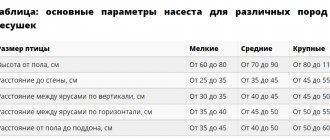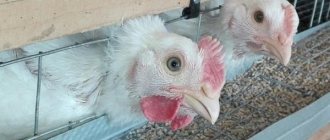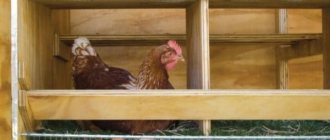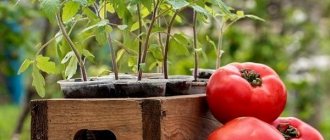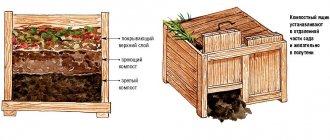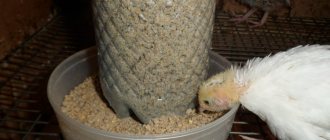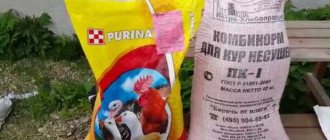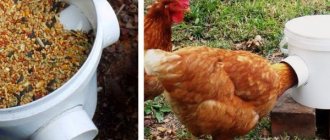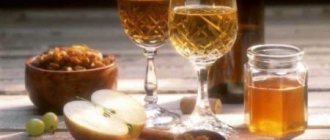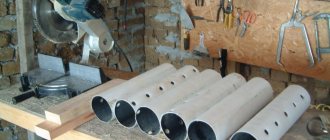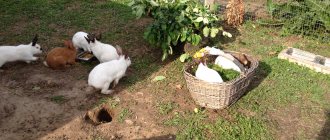Mixer for chickens
Recipe for 50 chickens.
- Boil 1.5 liters of crushed barley until half cooked and cool.
- Add 100 grams of meat and bone meal and chalk or shell powder, ground into powder.
- Add vitamins and preparations to increase egg production according to the manufacturer’s recommendations. Multiply the rate indicated in the instructions for 1 feeding for 1 bird by the number of birds (in our case, by 50).
- Add a large bunch of freshly picked and chopped herbs. In winter, you can replace it with 0.5 liters of sprouted grain.
- Mix. Add bran until the mixture crumbles in your hand.
- Two thirds of the grain can be replaced with boiled jacket potatoes. Before adding it to the general mixture, it should be cooled and thoroughly mashed with a masher.
Broiler mixer
Wet mash for broilers is made in the same way as for chickens, but there are nuances:
- It is better to replace grain in the composition with corn. It promotes weight gain;
- broilers need proteins, so more bone meal and meat products need to be given;
- Instead of water, use yogurt or skim milk;
- It is useful to include cottage cheese in the composition.
Chick mixer
Due to their age, chickens cannot eat grain, and mash will be the only alternative to feed. But they are prepared according to a different recipe than for adult chickens.
In the first week of life, chickens are fed a mixture of hard-boiled crushed eggs, slightly diluted with boiled water or dairy products. After this, the proportion of eggs in the diet is gradually reduced, and by the age of ten days they are completely removed.
Approximate composition for chicken 7–20 days per day
- grain – 10–15 g. It is better to take corn or barley. Chop very finely;
- meat and bone or fish meal – 1 g;
- meal – 0.6 g;
- potatoes – 4 gr. Cook without peel until tender, mash thoroughly so that no large lumps remain;
- cottage cheese -2 gr;
- milk -15 gr.
The last two products can be replaced with yogurt in the amount of 20 grams.
- greens – 7 gr. Optimal: dandelions, wheatgrass or rapeseed. Cut very finely;
- mineral supplements. Chalk, shell or shell – 1g. It is necessary to give it, since chickens need a lot of calcium and other minerals to grow.
Chickens do not immediately begin to peck at the mash; they need to be trained.
How to prepare the mixture
There are many different recipes for broiler mash. Each farmer makes adjustments to standard recipes based on his own observations.
Chicks and adults have different nutrient requirements. Therefore, birds of different ages have their own mash recipes.
Chicken feed option
Chickens are allowed to feed mash from the age of one week. When hay or grass meal, finely crushed grain, feed fat, etc. are added to the daily menu. To prepare wet mash for 10 birds use:
- barley or corn grits – 130 g;
- milk 150 ml;
- boiled grated potatoes – 40 g;
- fresh or dried herb – 70 g;
- cottage cheese – 20 g;
- meat and bone meal and mineral supplements 10 g each.
In the period from 10 to 30 days, chickens need high-calorie nutrition. They are also fed food waste and ground root vegetables.
Mash can be given to chickens from one week of age
Recipe for adults
Summer mash for chickens at home has some differences from winter mash. In summer, due to high egg production rates, it is easier for birds to replenish their reserves of nutrients. In winter, chickens eat food that is saturated with vitamins and minerals, because... in cold weather there is no grass.
Summer recipe
All ingredients are indicated for 10 adult chickens. mash for them is made from the following ingredients:
- Greens, peeled or whole potatoes, root vegetables - 500 g.
- Cereals – 450 g.
- Oatmeal or bran – 200 g.
- feed yeast – 70 g.
- Cottage cheese and whey (yogurt) – 100 g.
- Bone meal – 50 g.
- Pulses – 50 g.
- Fish oil – 10 g.
- Salt – 5 g.
Preparation is carried out in several stages.
- To make chicken mash, the first step is to cook the potatoes. It is pre-boiled and cut.
- At the same time, other root vegetables are boiled.
- Liquid is added to the chopped vegetables.
- Next, pour all the other ingredients into the pan.
- The last stage is cutting the salad. chickens are given: nettles, wheatgrass, tops of carrots, radishes, beets, alfalfa, wheatgrass. The chicken mash must not contain colchicum, nightshade or other poisonous plants.
At the same time, chickens should have the opportunity to walk around the pen. They will be able to independently obtain grass and make up for the lack of protein food.
Winter recipe
To prepare mash for chickens, the farmer needs to check that all the ingredients are present. wet food during the cold period contains factory premixes that help maintain egg production rates, enrich the poultry’s diet, and also provide a boost to maintain normal health.
The mash consists of the following components, the calculation is for 10 birds:
- potatoes – 1 kg.
- Cereals – 650 g.
- Herbal flour, cake – 70 g.
- Bran – 100 gr.
- Liquid (water, curdled milk, skim milk) – 1 l.
- Fish oil and bone meal – 20 g.
- Chalk – 30 g.
- Salt – 5 g.
The farmer should also make sure that fat-soluble vitamins are present in the diet. They are added to the feed according to the instructions.
Preparing wet food in winter is almost identical to summer. With one amendment, the liquid is preheated and then added to the feed. If there is no supply of grass meal, then the feeder is replenished with pine or spruce branches. By following these recipes, the farmer will achieve stable egg production and weight gain in chickens.
Read also: Sasso chickens: features of breeding at home
What is mash
A mash is a mixture of nutritious ingredients that are combined in a certain proportion, steamed with boiling water, and kneaded thoroughly. Properly formulated mash is a complete food that does not require additional feeding.
- The consistency of a properly steamed mash should be soft, but crumbly, remaining moist.
- If you take a handful in your fist, squeeze and then unclench your fingers, it should crumble in your palm.
- If a bird swallows a large and hard lump, it can damage the digestive tract, and too liquid a substance can clog the nasal passages.
Poultry farmers love such mixtures because many of the ingredients are interchangeable. You can adjust the composition using the products that are available.
Features of mash preparation
Homemade mixtures make the chickens’ diet balanced. The bird receives not only carbohydrates from grain, but also proteins, fats and vitamins.
- You need to make the mash strictly at once. The mixture quickly sours and causes digestive upset in chickens.
- You should not cook more than necessary and store it in the refrigerator. Maximum shelf life is 3 hours.
- You need to calculate the portion so that half an hour after feeding, the feeders are empty. If the chickens eat everything in 5-10 minutes, the volume of the mixture must be increased, since strong and high-ranking individuals often push the rest away from the feeder, and they do not have enough food.
- Empty dishes are washed thoroughly. Dried remains quickly begin to decompose, and the chicken that eats them at the next feeding may become ill.
- With two meals a day, mash is given in the morning feeding. They are easily digestible and very nutritious.
How to cook
In summer and winter, chickens’ demand for nutrients differs, so the mash must be prepared based on the needs of the bird.
Let's look at recipes for making mash in summer and winter as an example.
Summer recipe
Food in summer is characterized by a significant amount of green components.
For a good summer mash you will need (grams per 1 bird):
- potatoes, greens, root vegetables - 50;
- grains - 45;
- bran, oatmeal - 20;
- pulses - 5;
- flour, meal, feed yeast - 7;
- curdled milk - 10;
- bone meal - 5;
- chalk - 3;
- fish oil - 1;
- salt - 0.5.
Step-by-step cooking recipe:
- Boil the unpeeled potatoes, then cool and chop.
- At the same time as the potatoes, you can boil carrots or beets, zucchini, and overripe cucumbers from the garden.
- Add liquid (yogurt).
- Pour in crushed grains or mixtures thereof, bran, salt, flour (fish or bone), soybean cake or sunflower meal. You can add leftover boiled fish.
- Chop greens - nettles, dandelions, knotweed, meadow clover, alfalfa, wheatgrass, onion leaves, cabbage, carrots, garlic, radishes.
It should be remembered that a third of the mass of the summer mash should be liquid.
Compound
There is no single approved composition of mash. All acceptable ingredients can be divided into three groups.
The basis
Whole grains or cereals. In their whole form they produce grains of small diameter: millet or millet.
Related publications
Which dog food to choose: what to look for...
Sep 17, 2020
Review of premixes for chickens
May 1, 2020
Crushed grain. Large grains: corn or wheat, need to be crushed. It is better to include the latter in the diet of chickens or meat breeds, but give it to laying hens with caution, as it leads to rapid weight gain.
The optimal volume of the base is two thirds.
Nutritional supplements
Additional ingredients will help chickens get more micronutrients.
- Boiled vegetables. They can replace up to half the serving volume. Potatoes are usually boiled before adding; other vegetables are added raw. Wash thoroughly, boil in its uniform, then knead. Boiled vegetables have a moist texture, so more crumbly ingredients are added to the mash with them.
- Raw vegetables. Any grown in the garden. They are grated on a coarse grater into the cooled mash, but before adding bran.
- Grass. If there is a seasonal opportunity, it is necessary to add grass. Chickens love dandelions, nettles, rapeseed, wheatgrass, and clover. Bitter and dangerous herbs, spurge or hogweed, should not be added. The herbs are washed, doused with boiling water, finely chopped and added to a common pot.
- Broth, whey, hot water, return. These components are also interchangeable.
- Bran. Add until the consistency becomes crumbly.
Separately, it is necessary to say about food waste. You can add leftover soups, cereals, vegetable peelings and dry bread to the common pot. Nuances:
- All waste must be fresh. Soured and rotten ones cannot be added. Moldy pieces are not acceptable;
- there should be no medium-sized solid inclusions;
- Do not add foods high in salt, spices and sugar;
- Dry bread should be soaked in water or whey until soft before adding. Liquids are taken 3 times less than the volume of dry bread.
Important. Poultry farmers often ask how to steam and what to mix chicken feed with. Manufacturers claim that compound feed can and should be given only separately, in dry form. It contains everything necessary for the growth and development of the bird, and when steamed, the beneficial substances included in its composition are destroyed. There is also no need to add feed to the mixes.
Healthy Supplements
Ready-made premixes and vitamin-mineral supplements. They are good to add to mash, since all the ingredients are mixed and the optimal concentration of the additive in the feed is achieved.
- Yeast. Feed grade ones are best, but you can also use regular ones for baking. Before adding, dissolve in a small amount of warm water.
- Fish fat.
- Bone flour.
- Chalk or shellfish as a source of calcium. Can be replaced with crushed shells.
- Liquid kitchen waste containing protein. This can be whey, beef broth or skim milk.
There is no need to add boiled egg shells. When cooked, water-soluble calcium salts are washed out of it and the benefits of such an additive disappear. To disinfect, shells from raw eggs are calcined in the oven or kept in the microwave for 2-3 minutes.
Preparation of feed mixture for adult laying hens
The productivity of the chicken flock directly depends on the quality of the feed. For this reason, minerals and vitamins must be included in any of your own mash recipes. For chickens that must lay eggs, it is important to add components that increase egg production, for example, you can use the drug Felucen. To speed up the digestion of coarse components, it is necessary to place a shallow dish with fine gravel near the feeder with the mash.
The main components from which mash for laying hens is prepared:
- Shredded wheat;
- Ground barley;
- Ground corn;
- Boiled potatoes;
- Vegetables, grated;
- Sunflower or soybean meal;
- Meat and bone meal;
- Table salt;
- Feed chalk;
- Feed yeast;
- Fine gravel;
- Almost any greens (from the garden or picked in the field);
- Pre-sprouted grain;
- Small shell;
- Egg shells;
- Kitchen scraps and scraps;
- Various premixes selected taking into account the age of the bird and its productivity;
- Fish or meat broth;
- Dairy products.
When mixing the feed mixture, it is necessary to maintain the proportions of adding individual products. Basically, the diet consists of 60% of the total feed grain components, 30% succulent and green feed, and the rest - necessary additives. The prepared mixture is mixed well, diluted to a loose consistency with broth, whey, or if they are not available, then with water.
When feeding mash, you need to pay attention to the following:
- You need to use different grain components.
- If your bird eats the wet mash quickly, in 20-30 minutes, the chickens are starving, you need to give more food;
- If it takes more than 30-40 minutes, you need to reduce the single portion of the feed mixture.
Compound feed or mash
Poultry farmers have different opinions on this matter. Homemade and feed mixtures have pros and cons.
That's why they alternate. In the morning feeding they give mash, in the evening - granulated feed.
Advantages of mash:
- accessible composition, almost all components are available on the farm;
- quality control. You can be sure that there are no harmful chemicals or low-quality raw materials.
Disadvantages of mash:
- waste of time. It takes about an hour to make every day.
There is often an opinion that mash is more expensive than mixed feed. But if you produce most of it on your own farm, it will be cheaper.
Pros of pelleted feed
- saving time. No cooking required;
- can be stored for a long time. You can purchase feed for the entire season at once and store it in the barn.
Advantages and disadvantages of feeding mash
Advantages:
- natural and affordable ingredients that can always be found on the farm;
- the ability to control the composition of the mixture and the quality of its constituent products;
- absence of harmful substances in them.
- there is no need to feed the bird first with grain and then with other products, all together can be given to the chickens at one time.
Flaws:
- cooking time (about 1 hour);
- you need to prepare it every day, since you cannot store wet food: the mixture spoils quite quickly;
- Sometimes preparing mash is unprofitable from an economic point of view, since in some cases it turns out to be more expensive than ready-made mixed feed.
